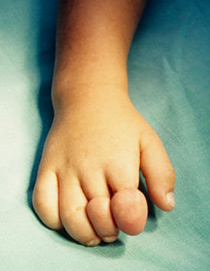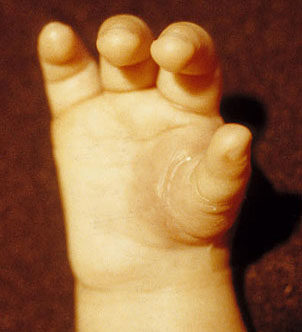Congenital Malformations
What are Congenital Malformations?
A congenital malformation, now referred to as Congenital Hand Differences or Congenital Upper Extremity Differences, is any physical defect that presents during fetal development at birth after developing in-utero. These malformations can involve the hands, wrists, elbows, and arms, as well as the heart, gastrointestinal tract, blood, chest, spine, and legs, among others.
Congenital malformations of the upper extremities can range in severity from fingers that cannot move fully to a wrist that deviates toward the thumb or pinky, as with the club hand malformation.
There are many reasons that congenital malformations can develop. These include random chromosomal defects and single gene defects as well as the dominant or recessive inheritance of diseases and genes that cause congenital malformations.
These malformations can often be identified while the baby is still in-utero, allowing specialized surgeons to often address issues in-utero or once the baby is born. HandSport Surgery Institute works closely with the families of children with congenital malformations and with adults who were born with congenital malformations to address and optimize these issues.
Signs and Symptoms of Congenital Malformations
Many congenital malformations are diagnosed in-utero if the mother has access to expert prenatal care and testing.
Once a baby is born, these malformations may be highly visible, such as a hand with too many fingers (polydactyly defect). However, there are a few congenital malformations that may be less obvious, such as camptodactyly, where one or more fingers are unable to be fully extended.
Though there may be no signs that a congenital malformation is developing through the mother’s health, prenatal ultrasounds can lead to the identification and diagnosis of many malformations in a fetus.
If you or your child has been diagnosed with a congenital malformation, trust that Dr. Jason Pruzansky and Dr. Mark Pruzansky of HandSport Surgery Institute will be able to offer you a full diagnosis following your exam, as well as a treatment plan to address your concerns.
Types of Congenital Malformations
Since every part of the body can be affected by a congenital malformation, there are numerous types of malformations that could affect a fetus as they are developing.
Polydactyly
Polydactylism is an anomaly or inherited trait in which the hand develops an extra finger in utero. This extra finger often branches off of the thumb or pinky finger. It is less common for a person with polydactylism to have a fully formed and functional finger.
If a child is born with polydactylism, it is best to have it treated early in life so that the child has the most time to meet their functional milestones.

Constriction Band Syndrome
Constriction band syndrome is thought to be the result of an in-utero accident in which the amniotic sac partially ruptures and the thread-like fibers of the amniotic fluid become entangled with the fetus’s extremities.
In minor instances, this can result in arms, hands or fingers that have a permanent but superficial constriction mark. In more serious cases, digits can be undersized or suffer from inadequate circulation.
Neonatal surgical intervention is necessary in some cases to perform scar reduction or removal to save the finger or hand.

Camptodactyly
This congenital malformation typically affects the tendons, muscles, joints, and skin of a person’s fingers. This is a condition in which fingers cannot be fully straightened or extended.
Oddly shaped joints, abnormal muscles, foreshortened tendons and tight skin can all contribute to camptodactyly, which is normally treated by splinting and physical therapy in mild cases and surgery in severe instances.
The cause of camptodactyly is not clearly understood by the medical community, but modern treatments are often able to improve the functionality of the afflicted fingers and improve movement.

Club Hand
Club hand is a congenital malformation in which the axis of the wrist is either deviated toward the thumb or pinky.
Although the condition is most visible in the hand and wrist, the origination malformation actually occurs in one of the forearm bones, in the radius or the ulnar. Other local and central anomalies generally accompany club hand.
Treatment of club hand should begin during childhood, preferably before a child starts writing or using their hands frequently. Treatment type depends on the condition’s severity and can include anything from splinting and stretching to surgery.
If you or your child were born with club hand, the surgeons at HandSport Surgery Institute can develop a treatment plan to correct the malformation and improve function to the affected limb as much as possible.

Syndactyly
This congenital malformation occurs when the fingers or toes are either conjoined by soft tissue or by fused bones.
Although simple webbing normally doesn’t impact the functionality of the hands or feet, more complex cases may demand surgical separation of the digits to reduce impairment and improve dexterity.
In some cases, an individual with syndactyly will require revision surgeries in the case of the webbing “growing back” over time.

Thumb Deficiency
Thumb Deficiency is often treated with Pollicization, and is characterized by the substitution of a functioning finger for a deficient thumb.
Pollicization substitutes a functioning finger for a deficient thumb. Pollicization is a reconstructive surgery in which the index finger is migrated to the position of a thumb.
Primarily used for infants and other patients who were born without a thumb or have lost it in injury, pollicization entails shifting the index finger and rotating it to the thumb’s usual orientation while leaving its arteries and veins attached. Then, the finger is connected to the tendons that are left over from the previous thumb, or substituting those of the index finger, to improve the function of the thumb.
Getting a Diagnosis for Congenital Malformations
Many structural congenital malformations are diagnosed in-utero through ultrasound, while other malformations can also be confirmed using advanced testing such as nuchal translucency, beta hcg, the triple screen, quad screen, and cell-free DNA tests.
At Handsport Surgery Institute, surgery is the last option and we prefer to work closely with patients and their families to work through the different treatment options available for congenital malformations, like physical therapy, stretching, or splinting before surgery becomes an option.
The earlier a patient is seen for congenital malformations, the better the likelihood that they will be able to regain function of the afflicted limb.
Treatment Options for Congenital Malformations
With over 40 years of combined experience, Dr. Mark Pruzansky and Dr. Jason Pruzansky are able to treat all forms of structural congenital malformations and other orthopedic conditions. Because of their level of expertise and specialization, Dr. Mark Pruzansky and Dr. Jason Pruzansky have successfully performed surgery on some of the most complex injuries and conditions to help their patients regain function and comfort following instances of congenital malformation or injury.
Non-surgical Treatments for Congenital Malformations
Depending on the type of congenital malformation you or your child have been diagnosed with, the team at HandSport Surgery Institute could treat the affected limb with conservative, yet effective. Treatments such as stretching, splinting, or by using a cast to reshape the affected area.
Based on your individual circumstance, your HandSport Surgery Institute team will be able to determine the best non-surgical treatment available to you.
Surgery for Congenital Malformations
For more severe cases of congenital malformations. Dr. Mark Pruzansky and Dr. Jason Pruzansky are able to treat patients using leading-edge surgery to separate or treat the affected digits, joints, or limbs.
If You Believe You or Your Child Have a Congenital Malformation, Contact HandSport Surgery Institute
Please contact us as soon as possible to schedule an appointment with our talented team. Congenital malformations are best treated as early as possible to help the patient regain as much functionality as possible. Call Dr. Mark Pruzansky and Dr. Jason Pruzansky at 212-249-8700 to schedule an appointment and start to obtain an accurate diagnosis.



